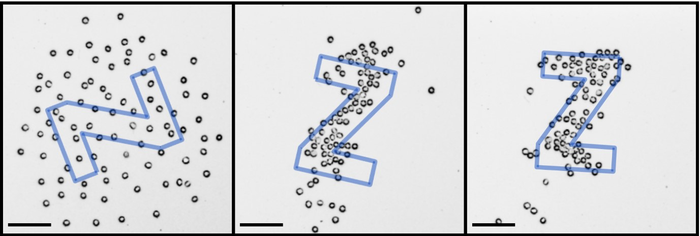Sep 23 2021Reviewed by Alex Smith
Complex natural formations such as arc-shaped rocks or star-shaped sand dunes can be purposefully formed by scientists. Researchers have considered that a specific combination of random and chaotic energy fields can, over an extended time, give birth to these types of distinct formations.
 Snapshots of a shape formation experiment showing several stages of the process, from the initial particle distribution to the end result. Image Credit: Artur Kopitca/Aalto University.
Snapshots of a shape formation experiment showing several stages of the process, from the initial particle distribution to the end result. Image Credit: Artur Kopitca/Aalto University.
However, only a few have been recognized as replicating the work of nature. Researchers from the Aalto University in Finland have discovered a method to simulate the natural processes that make intricate shapes and landscapes using a vibrating plate and resulting energy fields.
The findings of the study were published in the journal Science Advances on September 22nd, 2021.
The researchers generated the effect by distributing up to 100 particles of tiny metal balls, similar to the ones commonly used in soldering, onto a silicon plate, measuring 5 x 5 cm. A camera and smart algorithm enabled the researchers to trace and control the particles into required shapes, such as a letter of the alphabet. When the plate vibrated, it created a non-linear energy field.
We used the camera to determine the location of the particles, and the algorithm selected the most appropriate vibration frequency to move the particles in the desired direction. The particles move across the plate in a particular direction depending on the vibration frequency, and the same frequency can cause very different directions of movement in different parts of the plate.
Quan Zhou, Professor and Research Lead, Aalto University
The team was surprised to see the performance of the smart algorithm in predicting the movement of the particles at various frequencies, regardless of the complexity of their movement. The algorithm was able to effectively minimize the difference between the target shape and the actual particle distribution on the plate.
The movement of the particle swarm is similar to natural phenomena in which natural materials are shaped by the power of wind and water. The method should work at both smaller and larger scales, and could have many future applications where using hands or tools is difficult.
Artur Kopitca, Doctoral Candidate, Aalto University
Making a product with a specific shape essentially necessitates a mold or trained labor. The researchers believe that their technique inspired by nature could be employed to organize cells in medical and bioscience research and as an industrial production method.
An important question regarding the finding is the number of particles that could be controlled and ways to combine the method with other systems which possess similar dynamic characteristics, such as turbulent flows.
Previously, Professor Zhou’s team had investigated the characteristics of the vibrating plates and the way they can be used to direct particles along a certain path or toward the final destination. This is the first time the researchers stepped in to produce shapes by mimicking natural phenomena.
Journal Reference:
Kopitca, A., et al. (2021) Programmable assembly of particles on a Chladni plate. Science Advances. doi.org/10.1126/sciadv.abi7716.
Source: https://www.aalto.fi/en